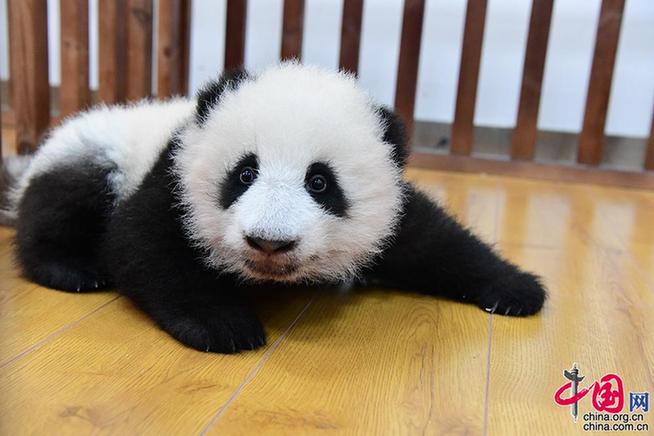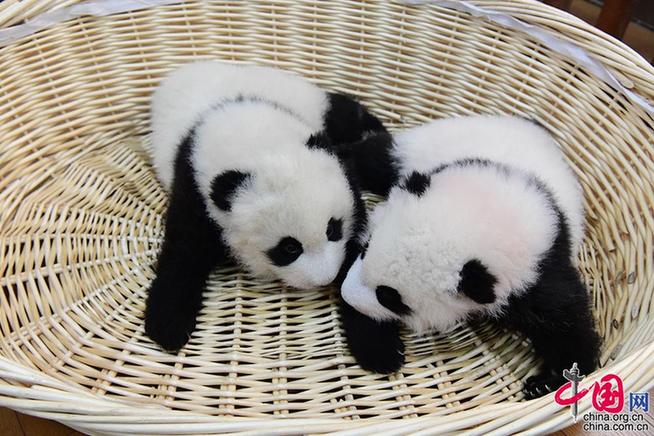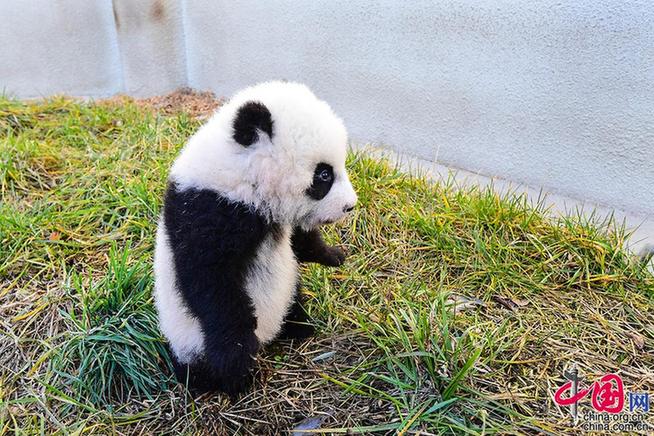

On February 3, 2021, on the occasion of the beginning of the spring, 10 2020 panda babies from the China Giant Panda Conservation and Research Center appeared at the Wolong Shenshuping base to send Chinese New Year blessings to the people across the country. (Photo by Li Chuanyou)
Adorable to everyone: Panda babies appear to celebrate the new year and send blessings
At 11 o'clock in the morning, the parents walked into the kindergarten playground with 10 baby pandas, and sent the most adorable New Year greetings to people across the country. Later, for the panda nurses, the dad put the active panda babies into the "New Year's cute box" with panda patterns, so that everyone can feel "you are in the open cute box" across the screen. "Little cute" suddenly appeared surprise, the parents also thoughtfully prepared for each baby panda a "bamboo basket red envelope" with the word blessing, which contains small snacks that the baby panda can eat, which also means good luck and good luck. Wish for them.
Next is the "free time" for the panda babies. In the playground, a "little train" and a "little castle" are built out of cardboard. The little guys smell and bite, and love the new toys. , But you are not welcome at all. The five-star red flags hung in the stadium are fluttering in the wind, and the red Chinese knots and couplets add joy. 10 baby pandas can enjoy the festive atmosphere and convey the festive blessings to everyone. The average age of the 10 panda babies that appeared this time is about half a year old. The oldest is the "Qianqian" twin sisters who spend more than 190 days, and the youngest is the "Shuqin" dragon and phoenix for more than 120 days, of which the birth weight of "Shuqin" is only 57.1. g, is the lightest baby panda born this year. Due to their young age, they are not very "destructive" to the New Year decorations in the venue, but they are full of curiosity. Every move and every move, a smile and a smile overturned everyone present.
According to Zhang Guiquan, a giant panda expert at the Panda Center, “In 2020, we will strictly follow the giant panda breeding pairing coefficient, and according to the estrus of giant pandas, scientifically and rationally promote the reproduction work. All giant pandas mate naturally. After the cubs are born, a few females The animal has a poor experience with cubs and needs to be artificially raised for four months and then returned to the mother animal. Now the cubs are nurtured by their mothers. This year, our Panda Center headquarters has bred 22 surviving cubs, plus 3 overseas, totaling 25 The baby pandas unveiled today are just a part of them. After the debut, we will return these babies to our mother in time."

2020 baby panda.(Photo by Li Chuanyou)
Harvest joy: the number of cubs accounted for more than half of the global number of surviving giant panda cubs
As of December 1, 2020, 44 surviving panda cubs have been bred globally, of which 25 surviving cubs have been bred in the Panda Center.
This year, while fighting the epidemic, the Panda Center is actively carrying out scientific research and breeding. The expert team overcomes pressure and difficulties through "cloud exchanges and cloud guidance", and guided Hong Kong and Taiwan regions and 7 foreign cooperation units to carry out giant panda breeding work. Taiwan giant pandas, giant pandas living in the Netherlands, South Korea, and the United States each gave birth to one litter, the highest number of litters born abroad in recent years.
In May, the Dutch giant panda "Wu Wen" gave birth to this year's first baby panda overseas, named "Van Xing". In July, the giant panda "Hua Ni" in South Korea gave birth to a cub, which promoted the scientific research of Chinese and Korean giant pandas. The cooperation has reached a new level; in August, the American giant panda "Meixiang" gave birth to cubs, which is currently the highest birth age record for overseas giant pandas; in September, the wildly introduced giant panda "Qiaoqiao" successfully gave birth to a captive population Add new genes; returnee giant pandas "Lin Bing" and "babies" respectively gave birth to cubs, and continued to write the story of friendship between China and Thailand and China and the United States.

2020 baby panda.(Photo by Li Chuanyou)
A successful conclusion of the "13th Five-Year Plan" and a blueprint for the future
During the "Thirteenth Five-Year Plan" period, the Panda Center made a major breakthrough in the scientific research and development of giant pandas, with a total of 155 surviving cubs. At present, there are more than 330 captive giant pandas in the Panda Center, accounting for more than 50% of the global captive population. The double-effect increase in the quantity and quality of captive populations and sustainable development have been achieved, which has laid a foundation for the development of scientific research work such as wild training and reintroduction, and introduction of wild species. Solid foundation. From 2016 to 2020, the Panda Center successfully reintroduced 6 captive giant pandas such as "Qinxin" and "Little Walnut", achieving for the first time the important goal of survival of captive giant pandas in their natural habitat and reproduction of endangered small populations in the region. During the 13th Five-Year Plan period, 5 female giant pandas participated in the wild introduction. Two of them gave birth to 8 cubs and 7 survived. This enriched the genetic diversity of captive giant pandas and optimized the genetic population structure of captive giant pandas.
Zhang Hemin, executive deputy director of the China Giant Panda Conservation and Research Center, said, “Since the “three difficulties” of giant panda breeding has been overcome, the captive population of giant pandas in China has continued to grow steadily, reaching the current 633. The wild population of giant pandas has grown since the 1980s. The number of giant pandas increased from 1,114 to 1864 in the decade, and the protected habitat area of giant pandas increased from 1.39 million hectares to 2.58 million hectares, effectively protecting 53.8% of the giant panda habitat and 66.8% of the wild giant panda population. This year coincides with the founding of the party. For the 100th anniversary, these 40 years of giant panda protection research work has been fruitful and hard-won achievements. All these are attributed to the wise leadership of the party and the country. A century-old party is flourishing and prosperous. I hope that the lovely national treasure panda will be the party’s centenary birthday. I offer my birthday wishes, wish the great party prosperity, send the most sincere New Year blessings to the people of the country, and bring joy and laughter to the people of the world."

2020 baby panda. (Photo by Li Chuanyou)


点击右上角![]() 微信好友
微信好友
 朋友圈
朋友圈

点击浏览器下方“ ”分享微信好友Safari浏览器请点击“
”分享微信好友Safari浏览器请点击“ ”按钮
”按钮

点击右上角 QQ
QQ

点击浏览器下方“ ”分享QQ好友Safari浏览器请点击“
”分享QQ好友Safari浏览器请点击“ ”按钮
”按钮
